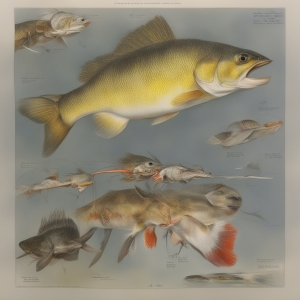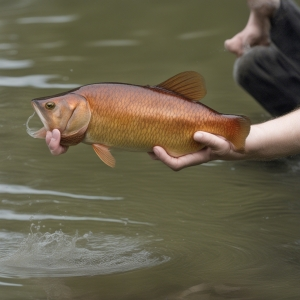Table of Contents:
The Art of Catch and Release: A Conservation Practice in Fishing
The art of catch and release is not just a casual approach to fishing, but a critical conservation effort that protects our aquatic ecosystems. For fishing admirers and outdoor enthusiasts, it is a sustainable and responsible way to enjoy the passion for fishing while caring for the environment. This practice is a cornerstone in modern sport fishing. It is adopted worldwide to preserve fish populations, and perform exactly how it sounds: catch the fish and release it back into the water.
In essence, catch and release is the perfect match for the two usually opposite sides: the exhilaration of fishing and the necessity for conservation. This balanced approach ensures future generations may experience the same joy and passion for fishing as we do today. So, how does this unique practice work, and how can you contribute to this noble cause? Let's dive in!
The Importance of Catch and Release in Fishing
Catch and release is a practical solution to many problems plaguing our aquatic life. Overfishing is one of the major threats to fish populations and marine ecosystems around the globe. With the global demand for fish gradually increasing, the effects of overfishing have become even more severe. The catch and release approach helps combat this issue effectively.
By releasing the fish back into its natural environment, we conserve the life of that creature and contribute to maintaining the balance of the ecosystem. Fish population is thus preserved and continues to thrive, ensuring a good fishing experience for many years to come. More importantly, it supports biodiversity and helps sustain healthy aquatic environments.
Thus, catch and release isn't just about sport. It's a vital part of worldwide conservation efforts and plays a significant role in maintaining the overall health of our planet's water bodies.
Pros and Cons of Catch and Release in Fishing
| Pros | Cons |
|---|---|
| Helps to conserve fish populations | Can cause stress and injury to the fish |
| Allows for sport fishing without depletion | Not all fish survive the release |
| May increase the size and quantity of fish over time | Potential to spread diseases among fish population |
| Encourages responsibility and ethical fishing practices | Requires proper techniques to ensure fish survival |
| Promotes education and awareness about marine conservation | Sometimes seen as cruel or unsporting |
The Basics of Catch and Release

Learning the basics of catch and release isn’t a complex process, but it does require a bit of knowledge and patience. As the name suggests, in catch and release, fishermen catch the fish and then release them back into the water. But there is a little bit more to it than just that simple explanation.
Firstly, you need the right equipment. Use a fishing rod and line that is appropriate for the size of the fish you are trying to catch. Using a line that is too weak may lead to the fish getting injured. Also, using barbless hooks can help reduce injury rate in fish as they are easier to remove.
Once you have the fish hooked, handle it as gently as possible. Avoid touching the gills or eyes, as these are sensitive areas. When ready to release, slowly lower the fish back into the water to avoid any physical shock.
Also, pay attention to local rules and regulations regarding specific catch and release practices for different species. These laws are usually put in place by local authorities to protect certain species or habitats. Following them not only contributes to conservation efforts but also keeps you out of potential legal trouble.
How to Properly Practice Catch and Release
Catch and release can be a lifesaver for fish if performed correctly. It's an art that enriches the fishing experience while conveying a great respect for nature. Here are some steps to make sure you're doing it right.
After you've hooked a fish and brought it near, minimize its air exposure. Fish breathe in water, not air, so prolonged exposure to air can harm the fish. If you need to take a picture, do it quickly while keeping the fish close to the water.
Use a wet handling glove or wet your hand before handling the fish. Doing this protects the fish's outer mucous layer, which defends it against infection and parasite. Ensure you hold the fish horizontally, never vertically, as it can damage their internal organs.
Be mindful of the hook-removal process. Use long-nosed pliers or a special hook-removal tool to gently remove the hook. If the fish is deeply hooked, it's better to cut the line as close to the hook as possible.
Finally, when it's time to release the fish, make sure to release it gently into the water. If possible, place the fish in the water, supporting it from underneath until it swims away on its own. This gives the fish time to recover before it swims off, reducing the risk of them becoming easy prey.
Remember, practicing catch and release responsibly makes the difference between life and death for the fish and contributes to healthier fish populations.
Essential Tools for Catch and Release Fishing

Now that you understand the importance of catch and release in fishing and its contributions to conservation, it's time to gear up with the right tools that enhance this process while ensuring the survival of the fish. To practice catch and release correctly, the use of specific tools can fundementally increase the fish's chance of survival post-release.
Barbless hooks: One of the first things you should consider is the use of barbless hooks. These hooks are designed to make hook removal easier and less stressful for the fish, leading to higher survival rates post-release.
Fishing nets: It is preferable to use a rubber-coated net for catching the fish. Such nets play a crucial role in preserving the layer of protective slime on the fish’s skin, which protects the fish from disease and infection. Mesh nets tend to strip off this layer.
Hook removal tool: A long-nosed pliers or a de-hooker can help in the safe removal of the hook without causing much damage to the fish.
Wet handling gloves: As mentioned earlier, these gloves help in preserving the slime layer on the fish when you touch them.
Measuring board: If you're keen to keep a record of the fish size without harming them, using a measuring board can be a non-intrusive method rather than weighing them.
Above all, the most essential tool of all is knowledge and understanding. Knowing how to handle fish correctly, when and how to release them to ensure their survival is the most vital skill of all. With this toolkit and the right techniques, you can enjoy a rewarding fishing experience while actively participating in the conservation of our beloved aquatic creatures.
The Impact of Catch and Release on Fish Populations
When practiced responsibly, catch and release plays a vital role in preserving fish populations. Once a caught fish is released back into the water, it carries on with its life, which includes breeding. Every released fish contributes to sustaining the population, making fishing possible for future generations.
Moreover, it also prevents depleting the stock of mature, breeding fishes. Smaller or juvenile fish usually make up a large proportion of the catch. By letting these go, you’re allowing younger fishes a chance to mature and breed, promoting the growth and stability of the species.
In the bigger picture, catch and release can greatly contribute to balancing the strain put on fish populations by commercial fishing techniques. If done right, it goes a long way in alleviating the problem of overfishing.
In essence, catch and release is not just about single fish survival, it's about the broader ecosystem, the health of entire fish populations, and the future of fishing as a sport and hobby.
Ethics of Catch and Release Fishing

Fishing, particularly when approached from a catch and release perspective, connects us to our primal hunting instincts while inspiring a deep respect for nature and its inhabitants. It presents us with a challenge and immerses us in the beauty of the great outdoors. However, this admiration for nature bears with it a significant ethical responsibility.
Lifelong anglers and newbies alike should bear in mind that fishing isn't just a sport or hobby but a way of interacting with a delicate ecosystem. Even though fishing tools and techniques have evolved, the ethical aspect of fishing still stands firm. It dictates our conduct while using shared resources, impacting both the environment and the enjoyment of other anglers.
A keen emphasis should be placed on respecting the local fishing regulations, which often embody best practices honed over years of scientific research and field experience. These rules protect the habitats and spawning grounds, ensuring their survival for future generations of both fish and anglers. Moreover, treating every caught fish as a valued living being regardless of size or species is the hallmark of a true and ethical angler.
Beyond regulations, practicing catch and release ethically involves improving one's skills and knowledge. Faster fish landing, proper hook removal, limited exposure to air, and careful release capitalize on the fish's remarkable resilience, enhancing their survival chances. These are all skills that can be learned and honed over time, underlining that the essence of ethical fishing lies not just in knowing why but in understanding how.
Finally, the ethical angler is one who leaves no signs of their presence other than fading footprints on the water's edge. Packing up all the litter, not just one's own, and minimizing noise and disturbance fosters a serene, clean, and healthy environment for all inhabitants- human, fish, and wildlife alike.
Conclusion: The Role of Anglers in Conservation
At the end of the day, catch and release is more than a mere fishing practice; it is a conservation ethos. As anglers, our role extends beyond the thrill of the catch and become the stewards of the waters we love so much. Our actions and decisions from using the right tools to practicing proper release techniques significantly impact the health of the fish population and, ultimately, the marine ecosystems.
Committing to the method of catch and release, you are making a conscious decision to prioritize the life of the aquatic creatures we admire over the record-sized catch hanging on your wall. And there is a rewarding feeling that comes with knowing that your favorite fishing spot is home to a thriving fish population, in part, thanks to your responsible actions.
Indeed, catch and release may require extra effort and care, but it is an essential contribution to conservation. It's a testament that we, as anglers, are part of something greater than ourselves, a global effort to protect and preserve the world of fish that we all enjoy so much.
A Comprehensive Guide to Catch and Release: Preserving Marine Life
What is catch and release?
Catch and release is a fishing practice where fish are caught and immediately released back into the water. It’s a conservation method aiming to preserve fish populations and ecosystems.
Why is catch and release important?
Catch and release is vital to the preservation of fish species and their habitats. It helps maintain fish populations and allows them to reproduce effectively, promoting biodiversity.
How to properly catch and release fish?
The key to catch and release is minimizing harm to the fish. This includes using barbless hooks, avoiding unnecessary handling of fish, and ensuring fish stays in the water as long as possible before release.
What is the impact of catch and release on fish populations?
When done correctly, catch and release can have a positive impact on fish populations by allowing more fish to reproduce and grow. It helps in maintaining a balanced and thriving aquatic ecosystem.
Is catch and release ethical?
While opinions vary, many believe catch and release to be an ethical fishing practice because it emphasizes the health and preservation of fish. However, it is also important to practice it correctly to minimize the harm to fish.







